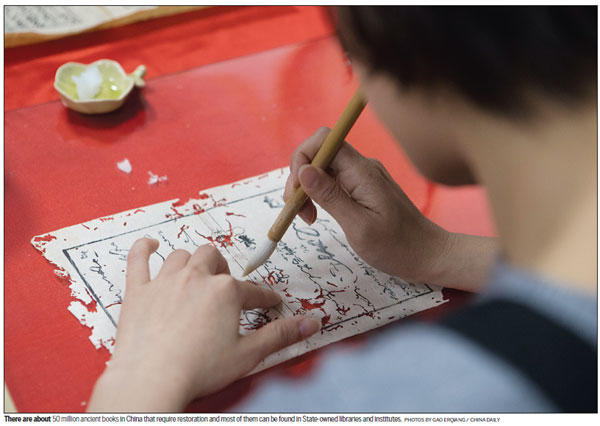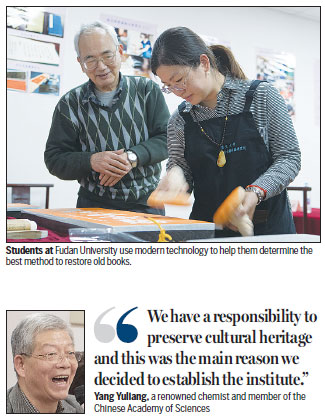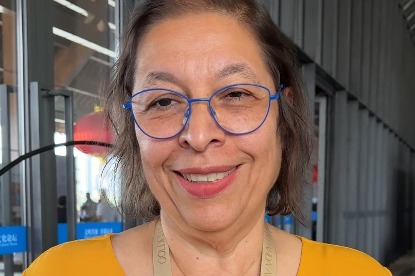The new generation of 'book doctors'

A special institute within Fudan University, one of the most prestigious in China, is offering a unique course that trains people to use science to restore precious ancient Chinese books to their former glory
Ten years ago, there were only around 150 book restoration experts in China.
In light of a growing appreciation for ancient culture, a thousand others have since entered the fray, but what lies ahead of them is a seemingly impossible task - it is estimated that there are some 50 million books in the country that are in need of restoration.
One of those that have been playing a key role in the efforts to boost the number of book restoration experts is Shanghai's Fudan University, which in 2014 established a unique institute that uses science to aid the conservation of ancient texts.
The Chinese Ancient Books Preservation and Conservation Institute of Fudan University is among the handful of establishments in the country that provides advanced training in this niche industry. There are currently 24 students in the institute - they hail from different academic backgrounds and countries - learning the delicate art of restoring ancient Chinese books to their former glory.
The institute is helmed by Yang Yuliang, a renowned chemist and member of the Chinese Academy of Sciences who also used to be the president of Fudan University. The course is currently only available as a three-year post-graduate program but the university said it is looking to offer undergraduate and doctoral courses in the future.
"We have a responsibility to preserve cultural heritage and this was the main reason we decided to establish the institute," Yang told local media during the introduction of the new department.
Yang has been studying ancient Chinese paper for years to determine the reason behind its incredible durability. He said that the most premium ancient Chinese paper can last more than 4,000 years, a stark contrast to modern paper. He pointed out that even the finest paper used to print money today can last no more than 400 years.
And therein lies the problem in the restoration of ancient books - the quality of paper used to restore ancient texts need to be on par with those created thousands of years ago, else the repaired areas might decay even before the rest of the book does. This has been the problem for many of the ancient books that underwent restoration in the 1960s, he added.
Traditional papermaking techniques disappeared around the 1900s and was promptly replaced by modern methods introduced by Western countries that could produce paper more efficiently and at a much lower cost.
As such, there is a need to recreate paper from the past. To do so, Yang and his colleagues at the institute studied old documents that detail the production process of "Kaihua paper".
This exquisite paper was used in the printing of ancient canons and is believed to be made using a specific plant from the wikstroemia species called Raohua that results in particularly long fibers in the finished product. The team has been growing the plant in areas near Kaihua county, Zhejiang province, where the paper was originally produced.
In order to remove the glycoprotein in the skin of the plants, ancient papermakers used to keep the plants in moist conditions for as long as a year, said Yang. Scientists today, however, can employ modern processes to produce the same result in a much shorter time.
Workers also used to step on the paper pulp repeatedly to remove unwanted elements without damaging the fibers. To replicate this process, Yang and colleagues developed a mechanical device that can achieve the same effect.
Following years of hard work, the team finally made a major breakthrough and created paper that weighs as little as 2 grams per square meter.
"You can hardly detect it when it is glued on an ancient page," said Yang.
Because the field of book restoration and conservation has rarely been covered in the higher education system, Fudan University has had to allocate a special funding to hire veteran artists and craftsmen to teach the students.
Professor Zhao Jiafu, an expert in seal cutting, inscription rubbing and ancient book restoration, is one of these individuals. He said that modern technology has allowed book restoration experts to analyze the specific cause of damage and acquire detailed information about the material they are working with. He also noted that using technology to support the craft of restoration has never been done before.
The 74-year-old has been in the field for more than half a century, having started his apprenticeship at the age of 17. Before retiring from the conservation department at Shanghai Library, Zhao had worked on many famous inscriptions in Shanghai.
For thousands of years, Chinese characters - from simple words to full-length poems and essay texts - have been inscribed on stone as a means of publicity and heritage. These inscriptions can be copied onto paper using the stone rubbing technique.
Another reputable craftsman teaching at the institute is Ni Jianming, a print artist who used to produce his own paper for his acclaimed artworks that have been exhibited around the world.
According to Ni, students in the course study the various process in print art - including composition, drawing and printing - as well as the different paper and ink used in ancient books as it helps them better understand the quality and texture of various types of print materials.
This would in turn enable them to determine the most effective restoration method to use.
During the course, he shares with the students his experience with the material, including how he used to make paper from recycled paper scraps. He also teaches them how to design and create ex libris stamps, a miniature print that expresses one's passion for reading and books.
"In this course, the students will learn about the whole process - from the birth of a book to the theory behind it to how they should treat an ancient book as a piece of art," said Ni.
"One does not need a deep knowledge in aesthetics before he can work in the restoration field. Artistic experience and aesthetic expression in the creative process are more important factors," he said.
He added that the students enrolled in the course have managed to come up with interesting ideas and have demonstrated a great desire to learn despite not coming from artistic backgrounds.
Wang Zhao is one such student. He used to study bioscience at an agricultural institute.
"I became interested in old books while reading one in the antique department of the local library. That was when I made up my mind to turn this interest into a career," he said.
Wang, who worked for two years before applying for the post-graduate program at the institute, said he was happy to discover that his knowledge in bioscience actually helped him perform more efficient inspection and data analysis of paper pulp.
A student who has more exposure in the field is Li Jie. The 23-year-old said she "practically grew up in a museum" as her parents are antique restorers. As such, her interest in the craft of restoration was piqued since she was a child.
Li even managed to single-handedly restore the local chronicles of her county when she was an undergraduate student studying library science in Shaanxi province.
"We can't possibly reach the same standards as our professors in just two or three years because they have decades of experience. However, we can still help each other and improve as rapidly as we can," she said.
"There are 14 students in our class and though we may come from 11 different academic fields such as science, liberal art and engineering, we share the same ambition to devote our lives to prolonging the life of ancient books."
In April, the students held a print art exhibition at the Guanghua Building in Fudan University and showcased the ex libris stamps they created.
But while there is a massive number of ancient books in China that needs to be mended, the book restoration profession isn't exactly an iron rice bowl.
In China, most ancient books of cultural importance are owned by the government and stored in State-owned libraries and institutes.
These places usually have strict employment regulations because staff salaries are paid by government funding. As such, it is more difficult for such establishments to hire new staff such as book restoration experts.
The alternative would be to send old books to restoration workshops, but such businesses have yet to take off in the country.
Yang Guanghui, deputy director of the institute, said they are pushing for the creation of a State-level restoration center where ancient books in need of repair can be consolidated and worked on by course graduates.
zhangkun@chinadaily.com.cn



(China Daily USA 05/12/2017 page8)
Today's Top News
- Brazilian envoy: Ne Zha 2 wins global hearts
- China launches anti-dumping probe into certain US analog IC chips
- China pays its respects to 30 war martyrs
- Nation honors fallen soldiers returned from South Korea
- Equal consultation with mutual respect right way to settle TikTok issue
- Aid program must return to its roots






























